A pristine, white grotto where stalactites point at you like ivory daggers. A canyon just as Grand as those abroad and a haven for wildlife as well as hikers. Gnarled trees, that have seen many centuries go by and yet still bear fruit every year. Those are some of the amazing natural wonders of Puglia.
One of the great natural beauties in Puglia is what it surrounds it: the ocean. Hundred shades of blue. Oftentimes a vivid azure, sometimes turquoise green and few times a dark navy. And while many are drawn towards the sea, the inland of Puglia have amazing natural wonders, worth exploring when you’ve grown tired of lazing by the beach.
Grotte di Castellana – Caves from a Fantasy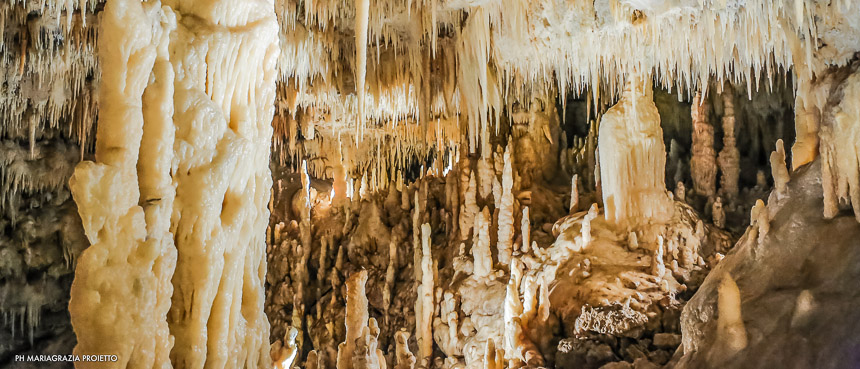
The caves of Castellana were first explored less than hundred years ago. Before that, the entrance to the caves, the so-called “demon’s hole”, was regarded with fear and superstition by the locals and used like a huge rubbish bin. When speleologist Franco Anelli lowered himself 60 metres into the pitch black back in 1938 it must have been with a bunch of butterflies in his stomach.
Once he had reached the floor of this first huge cave, an underground Pantheon, he spotted a corridor a passage partially concealed by stalagmites (mineral formations building from the ground and up) and stalactites (formed by dripping of water from the ceiling and down). He wiggled across those and came upon the first cave: Cave of the Monuments.
Now less than hundred years later, you can walk in his footsteps and discover formations such as “the Owl”, “the Altar” and “the She-Wolf”. On a three-kilometre tour you descend into the caves led by experienced guides that enlighten you on the history and geology of the caves. The – literally – highlight of the tour, at the end of the cave-system open to public, is the White Cave. A brilliant spectacle of ivory colours and shapes like icicles, melted wax, coral reef and other mineral formations, molded by nature in the last 2,5 million years.
Located just a 20-minute drive from the peculiar trulli of Alberobello, anyone with just an ounce of curiosity will enjoy the descent into subterranean Puglia to discover a true natural wonder and one of the most beautiful caves in Europe. The constant temperature of 16-18 degrees makes it a refreshing exploration in summertime and a mild excursion in the winter.
- The first cave is an underground Pantheon
- The awe-inspiring Monument’s cave. Photo courtesy of Grotte di Castellana
- Stalagmites and stalactites are almost touching each other
- The first cave is 60 metres deep
- The first cave is used as setting for the theatrical show “Hell in the Cave” based on Dante’s “Inferno”
- A brilliant spectacle of ivory colours in the White Cave. Photo courtesy of Grotte di Castellana
- Discover shapes like icicles, melted wax, coral reef and other mineral formations, molded by nature in the last 2,5 million years
- Grotte di Castellana website
- Grotte di Castellana on Wikipedia
- Grotte di Castellana on Puglia’s Tourism website
Gravina di Laterza – Grand Canyon of Puglia

Just like its American counterpart, the canyon of Laterza cuts deep into the landscape. Formed in the last 60 million years this incision in the terrain extends for 12 kilometers, sometimes reaching a depth of 200 metres and an average width of 400 metres. Gravina di Laterza is not the only ravine in this area in the north of Puglia, only 1/2 hour drive from the wondrous town of Matera in the region of Basilicata. But it’s the grandest. And one of the largest in Europe.
The gravine is an important treasure trove of biodiversity, a haven for flora, fauna and especially birds of prey. The nature park offers a stunning scenery and several options for hiking, bird-watching and nature exploration. It’s possible to hike along the edge of the canyon and really take in the vista.
The local CEA (Center of Environmental Education) offers guided walking and mountain bike tours into this stunning area, that is still relatively undiscovered by the average tourist and so provides a perfect opportunity for an authentic nature experience.
- The town of Laterza defiantly stares into the abyss of the gravine
- Formed in the last 60 million years this incision in the terrain extends for 12 kilometers
- Sometimes reaching a depth of 200 metres and an average width of 400 metres
- There are shelters for hikers, bikers and the local scouts
- It’s possible to hike along the edge of the canyon and really take in the vista
- The gravine is an important treasure trove of biodiversity, a haven for flora, fauna and especially birds of prey
- Gravina di Laterza website (in Italian)
- Laterza Tourism website
- Gravina di Laterza on Wikipedia (in Italian)
- Gravina di Laterza on Puglia’s Tourism website
Olive Trees – Millennia old living sculptures

60 million. That’s how many olive trees you’ll count to if you started counting those in Puglia. Whole carpets of silvery green welcomes the visitors arriving by plane, as the landscape of Puglia alternates between a rocky soil, turquoise ocean and this mediterranean greenery.
The olive tree is seriously rooted in history. Its oil has perfumed egyptian Pharaohs, massaged Greek athletes and illuminated the halls of kings, priests and common men. It has also become one the pillars of which mediterranean cuisine is based. Today, when you pour this golden liquid over your salad or bruschetta, it enhances the food with an aroma that is soaked in history.
The main varieties of olive trees grown in Puglia can be considered endemic because they have adapted to the terrain, the climate, the terroir over time. Their gnarled trunks are shaped by time and their patient branches bear the fruits as they have done for hundreds of years. When you see a proud specimen like that, a so-called ulivi secolari, it will probably be between 400 and 600 years old. When the tree becomes older, it twists itself to death; its trunk is divided and hollowed out by its own force until it’s too weak to bear more fruit.
Even unable to give fruit, the farmers are forbidden to cut down these old trees. Reaching prominent ages as old as 3.000 years these natural sculptures have witnessed ancient history, have survived the Greeks, Romans, Goths, Byzantines, Longobards, Saracens, Normans, Swabians, Angevins and Aragonese. Perhaps they will even survive us.
- There are 60 million olives trees in Puglia
- The olive tree is seriously rooted in history
- Their gnarled trunks are shaped by time and their patient branches bear the fruits as they have done for hundreds of years
- When you see a proud specimen like that, a so-called ulivi secolari, it will probably be between 400 and 600 years old
- Whole carpets of silvery green welcomes the visitors arriving here by plane
- Reaching prominent ages as old as 3.000 years these natural sculptures have witnessed ancient history
More info:
Perhaps you would like to learn more about The Peculiar Trulli of Puglia or discover the baroque beauty of Lecce. Here are some other helpful links to discover Puglia:
Learn more






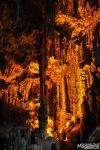
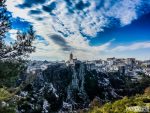

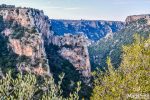





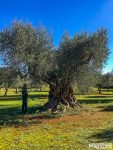






Oh my goodness…gorgeous!!! We’ll be travelling to Sardinia soon, but it looks like we’ll need to also plan for Puglia in a subsequent holiday.
Thank you for the kind words Michelle! Yes: you definitely need to visit Puglia.